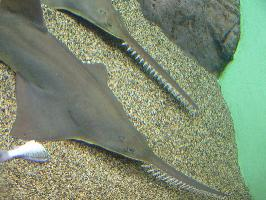
Poids et mesures
| Longueur | de 5,5 à 6 m |
|---|---|
| Poids | 350 kg |
Données biologiques
| Durée de vie | de 20 à 30 ans |
|---|
Description de l'animal
The Smalltooth sawfish, scientifically known as Pristis pectinata, is a remarkable and fascinating species of ray, belonging to the family Pristidae. This extraordinary creature is notable for its elongated, flat snout, which is edged with teeth and resembles a saw, a feature that not only gives the species its common name but also serves as a unique tool for hunting and self-defense. Despite its fearsome appearance, the smalltooth sawfish is a docile species, posing no significant threat to humans unless provoked.Characterized by a body that blends the streamlined grace of sharks with the flattened underside of rays, the smalltooth sawfish can reach lengths of up to 25 feet (7.6 meters), though individuals more commonly measure around 18 feet (5.5 meters). Their bodies are covered in a tough, leathery skin, with a coloration that typically ranges from a dusky brown to olive green on the dorsal (top) side, transitioning to a paler, almost white hue on the ventral (bottom) side. This color scheme provides excellent camouflage against the sandy and muddy bottoms of their habitats.
The most striking feature of the smalltooth sawfish is undoubtedly its saw-like rostrum, which is lined with a series of sharp, tooth-like structures called denticles. This saw is not only an effective tool for digging and probing the seabed in search of prey but also serves as a formidable weapon. By swinging its rostrum from side to side, the sawfish can stun or injure fish, crustaceans, and other prey, making them easier to capture. The rostrum also contains electroreceptors that allow the sawfish to detect the electrical fields produced by potential prey, an adaptation that is particularly useful in the murky waters where these creatures often reside.
Smalltooth sawfish are found in a variety of marine and brackish environments, including estuaries, coastal bays, and river mouths. Historically, their range extended throughout the tropical and subtropical waters of the Atlantic Ocean, from the United States and the Gulf of Mexico down to Central and South America. However, due to habitat loss, pollution, and overfishing, their populations have dramatically declined, and their range has become significantly restricted.
The reproductive habits of the smalltooth sawfish are intriguing. They are ovoviviparous, meaning that the eggs develop and hatch inside the female's body, with the young being born fully formed. This reproductive strategy, coupled with a low birth rate and long gestation period, makes population recovery particularly challenging for the species.
Conservation efforts for the smalltooth sawfish are critical. It is listed as Critically Endangered by the International Union for Conservation of Nature (IUCN), facing threats from habitat degradation, entanglement in fishing gear, and the illegal trade of its rostrum and fins. Protective measures, including habitat restoration, strict fishing regulations, and public education, are vital to ensure the survival of this unique and ancient species.
In conclusion, the smalltooth sawfish is a captivating and ancient marine creature, whose survival is intricately linked to the health of coastal ecosystems. Its unique physical attributes and ecological role underscore the importance of marine conservation efforts, not only for the sawfish but for the overall biodiversity of our planet's oceans.
Nouvelles photos d'animaux
Top 10 des animaux
- Dolphin gull (Leucophaeus scoresbii)
- Diana monkey (Cercopithecus diana)
- Moustached guenon (Cercopithecus cephus)
- Galápagos tortoise (Geochelone nigra complex)
- Russian tortoise (Testudo horsfieldii)
- Japanese macaque (Macaca fuscata)
- Stone loach (Barbatula barbatula)
- Greek tortoise (Testudo graeca)
- Common flying dragon (Draco volans)
- Colossal squid (Mesonychoteuthis hamiltoni)